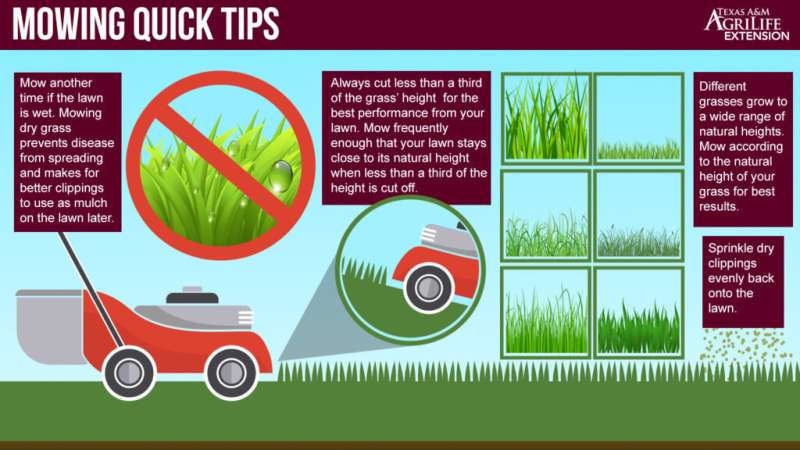AgriLife Extension releases new publication on mowing warm-season turfgrass

Mow high, mow low, mow often … ever wonder what the best recommendations are to ensure a beautiful lawn? Not doing it right can be detrimental to warm-season turfgrass, according to a Texas A&M AgriLife Extension Service specialist.
AgriLife Extension has released a new publication to help homeowners and other turfgrass managers properly execute the most common turfgrass management practice—mowing. The new publication is at https://aggieturf.tamu.edu/wp-content/uploads/ESC052-1.pdf.
"Mowing might seem like one of the simplest and most intuitive practices to many of us, as even children mow at a fairly early age to earn some extra money," said Dr. Becky Grubbs, AgriLife Extension turfgrass specialist in College Station. "However, mowing can also be one of the fastest ways to stress and compromise your turfgrass health."
Grubbs said it is not uncommon for mowing to be at the root of any number of turfgrass problems.
"People have a tendency to mow at an inappropriate height or frequency for their specific turfgrass species and cultivar," she said. "This can lead to added stress on their turf, and create opportunities for pest encroachment."
Grubbs said she designed the new publication as a simple guide to remind people of some key rules to proper mowing.
"There are a few things that are critical to maintaining healthy turfgrass when it comes to mowing," she said. "Start by mowing at the appropriate height for your species/cultivar. Make sure you follow the 'one-third rule.' And, take time to properly maintain your equipment."
In the case of St. Augustine lawns, for instance, she said it is not uncommon for her to see homeowners maintaining them at heights that are much too low, opening up opportunities for weeds and disease to move in.
"St. Augustine grass should be maintained between 2.5 and 4 inches in height, but it's not uncommon for me to see people mowing it much lower – the way they might for a Bermuda grass lawn," Grubbs said.
Two tables in the publication highlight appropriate mowing heights for Texas. Grubbs said there may be different practices in other parts of the country, particularly for cool-season grasses that thrive at lower mowing heights further north.
"This is really a guide for Texas turfgrass managers and homeowners," Grubbs said. "We include a few cool-season species, as we do see them in areas throughout North Texas, but the focus is more on warm-season turfgrass management."
She also points out that many people wait too long between mowing, ultimately removing more than one-third of the total turfgrass height each time they mow.
"When we do this throughout the season, we are essentially scalping and stressing our turfgrass each time by removing a large volume of its photosynthetic material and exposing the soil for weed encroachment in the process," Grubbs said.
"Following the one-third rule means that if, for example, I am trying to maintain a mowing height of 2 inches, I should really aim to mow by the time it reaches 3 inches in height."
She said this may mean mowing more frequently than some lawn owners are used to doing if they really want to keep their turfgrass healthy.
Finally, Grubbs said not to forget to take time to properly maintain equipment.
"Mowers are like any other tool," she said. "They will perform best when they are clean and sharp. Dull, dirty blades can spread pests and create entry points for disease. You wouldn't use dull shears to prune your woody plants, and the same principles apply here."
Provided by Texas A&M University

















